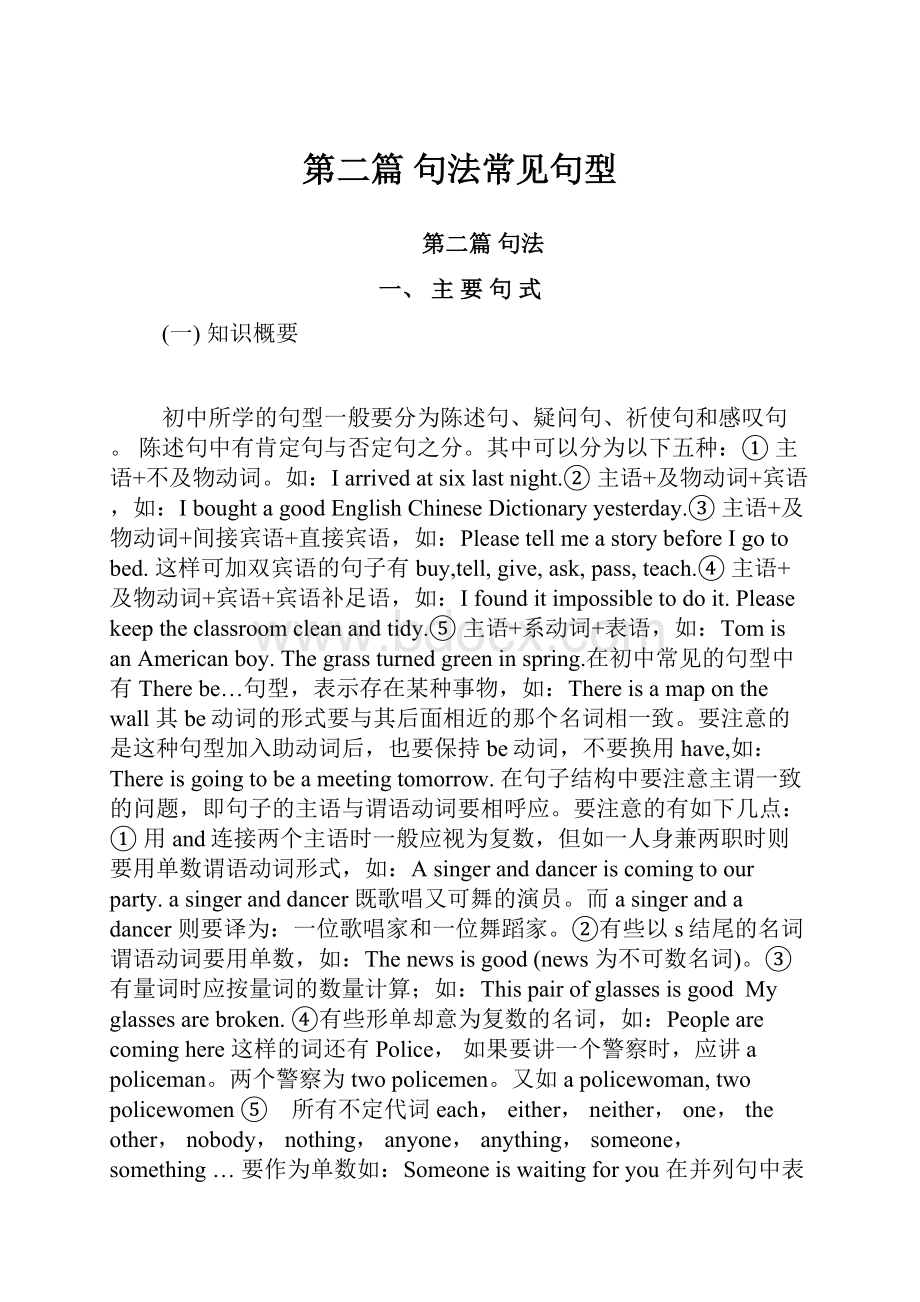第二篇 句法常见句型.docx
《第二篇 句法常见句型.docx》由会员分享,可在线阅读,更多相关《第二篇 句法常见句型.docx(17页珍藏版)》请在冰豆网上搜索。

第二篇句法常见句型
第二篇 句法
一、 主 要 句 式
(一) 知识概要
初中所学的句型一般要分为陈述句、疑问句、祈使句和感叹句。
陈述句中有肯定句与否定句之分。
其中可以分为以下五种:
①主语+不及物动词。
如:
Iarrivedatsixlastnight.②主语+及物动词+宾语,如:
IboughtagoodEnglishChineseDictionaryyesterday.③主语+及物动词+间接宾语+直接宾语,如:
PleasetellmeastorybeforeIgotobed. 这样可加双宾语的句子有buy,tell,give,ask,pass,teach.④主语+及物动词+宾语+宾语补足语,如:
Ifounditimpossibletodoit.Pleasekeeptheclassroomcleanandtidy.⑤主语+系动词+表语,如:
TomisanAmericanboy.Thegrassturnedgreeninspring.在初中常见的句型中有Therebe…句型,表示存在某种事物,如:
Thereisamaponthewall其be动词的形式要与其后面相近的那个名词相一致。
要注意的是这种句型加入助动词后,也要保持be动词,不要换用have,如:
Thereisgoingtobeameetingtomorrow.在句子结构中要注意主谓一致的问题,即句子的主语与谓语动词要相呼应。
要注意的有如下几点:
①用and连接两个主语时一般应视为复数,但如一人身兼两职时则要用单数谓语动词形式,如:
Asingeranddanceriscomingtoourparty.asingeranddancer 既歌唱又可舞的演员。
而 asingerandadancer 则要译为:
一位歌唱家和一位舞蹈家。
②有些以 s结尾的名词谓语动词要用单数,如:
Thenewsisgood(news 为不可数名词)。
③有量词时应按量词的数量计算;如:
Thispairofglassesisgood Myglassesarebroken. ④有些形单却意为复数的名词,如:
Peoplearecominghere这样的词还有Police,如果要讲一个警察时,应讲 apoliceman。
两个警察为 twopolicemen。
又如 apolicewoman,twopolicewomen⑤ 所有不定代词 each, either, neither, one, theother, nobody, nothing, anyone, anything, someone,something …要作为单数如:
Someoneiswaitingforyou在并列句中表示联合关系的连词有:
andnotonly … butalso, neither … nor, either … or如:
Mysisterandmyparentsaregoingtothecinema。
表示转折关系的并列连词有:
but 和 yet,如:
Sheisagoodstudent,butshedidn'tpassthefinalexam. 又如:
Ithinkthenewsisstrange,yetitistrue表示选择关系的连词有:
or, either … or,如:
Hurryup,oryouwillbelateforschool表示因果关系的并列连词有:
for, so 如:
Theystudiedveryhard, sotheyallpassedtheexam在初中范围复合句中主要有状语从句和宾语从句(名词性从句)两种,而定语从句(形容词性从句)要在高中讲述,为了使同学阅读文章方便,我们将在下面另一章予以介绍。
我们首先来看宾语从句。
① 在及物动词的后面可以接一个名词来充当宾语,如:
Iknewtheman, 而这时也可以用一个句子来充当宾语,如:
Iknewthathewasagoodman这时宾语从句的连接词有 that,(that 只在从句中起联接作用,不在句中充当语法成分,既不是主语也不是宾语,所以在口语中常常被省略。
如:
Iamsure(that)shehaspassedtheexam②if,whether 它们在宾语从句中只起连接作用,不起语法作用,当作是否讲。
从句中有 ornot 结构时,要用 whether, 如:
Iaskhimif(whether)hehashadhislunch Iaskshimwhetherhehashadhislunchornot ③ what 它在宾语从句中除了作连接词外,还要作主语或宾语成份,如:
Idon'tunderstandwhatyousaid (what 作 said 的宾语)。
又如:
Iaskedhimwhatmadehimsick(what 在宾语从句中作主语)。
④ who,它也和what一样,在句中除作连接词外,可以充当句中的成份,如:
Iknowwhosheislookingfor?
⑤ whose 如:
Iwanttoknowwhosebookthisis?
⑥ which 如:
Doyouknowwhichbookismine?
在连接词中还有4个常用的连接副词,① how 它的应用最广,如:
howmuch,howmany,howlong,howsoon,howold …。
如:
Howmuchdoesitcost?
② when 它只是连接时间状语,如:
Pleasetellmewhenthemeetingwillbegin?
③ where 它连接地点状语,如:
Whereareyoufrom?
④ why 它要连接的是原因状语从句,如:
TheteacheraskedwhyTomdidn'tcometoschool. 在考试中常见到的考点是:
宾语从句的时态与主句时态的呼应问题。
① 主句谓语动词如果是现在时或将来时,宾语从句的时态可以是任何所需要的时态,如:
Iknowhedidn'tcome. 我知道他没来。
Iknowhewillcometomorrow我知道他明天来。
IknowhehasgonetoLondon我知道他已去伦敦了。
② 主句中的谓语动词若是过去时,宾语从句也要用过去时态中的某一种。
比如:
一般过去时,过去进行时,过去将来时,过去完成时。
除了在表达宇宙中的客观真理时,不能用现在时态。
如:
Iwantedtoknowwhenhewouldcome Theteachertoldmetheearthmovesaroundthesun状语从句主要有时间状语从句,其连接词有:
after, before, when, as, assoonas, until(till),while, since, by其中较难掌握的有以下几点:
① until(till) 直到,在用 until 表达时间状语的句子中,主句中的动词是要十分小心去选择。
如动词是持续性动词,它要用肯定句,如:
Istudiedharduntil12o'clocklastnight. 如果动词是瞬间截止性动词,则要用否定句,如:
Hedidn'tgotobeduntilhismothercameback② 由since, for, by, before来引导的时间状语从句。
since 引导的时间状语是动作的开始时间,如:
IhavestudiedEnglishsince 1990而由 by 引导的时间状语通常是动作的结束时间,如:
Ihadlearned25Englishsongsbytheendoflastterm而before 则多用于完成时, ago 则多用于一般过去时,如:
Hehadfinishedhisworkbeforetwelveyesterday Ileftmyhometowntwoyearsago③ 在状语从句中用一般现在时或一般过去时表示将来。
它们可能是主句用一般将来时,从句用一般现在时,如:
Ifitrains,theywon'tgototheparkonSunday也可以主句是一般过去时,从句用一般过去进行时,如:
Hesaidifitrainedthenextdayhewouldnotgotothepark考试中常见的考点有:
要学生区别是条件、时间状语从句还是宾语从句,因在宾语从句中该用什么时态用什么时态,如:
Iwanttoknowifhewillcomeheretomorrow在宾语从句中的条件状语从句与主句的关系,如:
Iwanttoknowifitrainshewillcomeheretomorrow在原因状语从句中主要是① because,应译为"因为"。
它表达的因果关系最强,如:
Hedidn'tpasstheexambecausehedidn'tstudyhard② since 应译为"既然",如:
Sinceyouwereillyesterday Ileftsomenotesonyourdesk③ as 应译为"由于",如:
Asitistoohotwe'dbettergoswimmingsince 与 as 所表达的因果关系远比 because 弱得多。
而 for 表达的因果关系最弱。
它不能用于句首,如:
Hestudieshard,forhewantstogotocollege在比较状语从句中有同级比较 as … as,如:
Thisbookisasgoodasthatone要注意的有两点:
① as … as 中间要用原级而不是比较级。
② 用形容词还是副词,如:
MarywritesascarefullyasTom而其否定句为 notas(so) … as,如:
Theydidn'tworksohardaswedid, 而不同级比较用比较级加 than, 如:
HeisyoungerthanIam要注意的是表示"越来越"这一概念时有两个句型:
① 比较级+and+比较级,如:
Thedaysaregettinglongerandlonger Thelittlegirlisbecomingmoreandmorebeautiful② 定冠词 the +比较级+ the +比较级,如:
Theharderyoustudy,themoreyoucanlearn方式状语中要注意的是as(连词)与 like(介词)的区别。
as 作为连词其后接从句,如:
PleasedoitasIdidit但后面的句子常作省略,如:
PleasedoitasI而 like 是介词,其后要接的是宾语,如:
Pleasedoitlikeme结果和目的状语从句主要有 so … that, sothat, inorderthat等几种用法。
① so … that用在单数可数名词前,so +形容词+ a +名词+ that,如:
Sheissobeautifulagirlthateveryonelikesher或用 such+ a +形容词+名词+ that, 如:
Sheissuchabeautifulgirlthateveryonelikesher② 在不可数名词或可数名词复数前只能用 such,如:
Itissuchgoodweatherwewanttogoforapicnic又如:
Theyaresuchgoodplayersthattheyshouldwinthegame. ③ 在much, many, few, little 之前只能用so,如:
IhavesolittlemoneythatIcan'tbuyit④ so … that 之间只有形容词时,则不能用 such,如:
ItissogoodthatIwanttobuy⑤ sothat 其后接从句,如:
IgotupearliersothatIcouldcatchthefirstbus
(二) 正误辨析
[误] Thestoriesinthatbookwaswrittenmanyyearsago
[正] Thestoriesinthatbookwerewrittenmanyyearsago.
[析] 作主语的名词、代词或不定式、动名词,它们往往要带有修饰词,这些词可能是形容词,也可能是短语,但谓语动词还是要取决于这个主语的数,要记住的是一个名词不可能在同一句中作两个不同的语法成份,如:
book 作了 of 的介词宾语则不可能再作主语了。
[误] Toreadmanybooksaregoodforyou
[正] Toreadmanybooksisgoodforyou
[析] 不定式作主语应该看作单数主语。
[误] Whathesaidareright
[正] Whathesaidisright
[析] 从句作主语一定要按单数主语看待。
[正] Therichisnotalwayshappy
[误] Thericharenotalwayshappy
[析] 形容词+定冠词表示一类人,谓语动词应用复数,如:
Theyoungareveryinterestedinstudyandsports
[误] Theschoolmasterandwriterarecoming
[正] Theschoolmasterandwriteriscoming
[析] 本句应译为:
校长兼作家就要来了。
而 Theschoolmasterandthewriterarecoming则要译为:
校长和一个作家要来了。
在英语表达法中确实有 Thegirlandboyareplayingonthegrass这应译为:
一个女孩,一个男孩在操场上玩。
因为不可能这样两个概念作用在一个人身上。
又如:
thehusbandandwife夫妻二人。
[误] Youorshegotogetsomewaterforus
[正] Youorshegoestogetsomewaterforus
[析] 由 or 连接的两个主语应以离谓语动词近的那一个计算其数。
这样的用法还有 either … or,neither … nor, notonly … butalso 也有人称作"就近原则"。
[误] Theteacherwithalotofstudentscomeintotheclassroom
[正] Theteacherwithalotofstudentscomesintotheclassroom
[析] 真正的主语是 theteacher,而 with 短语是伴随状态,不影响主语的数。
[误] Myglassesisbroken
[正] Myglassesarebroken
[误] Thispairofglassesaregood
[正] Thispairofglassesisgood
[误] Thesekindsofbutterisgood.
[正] Thesekindsofbutteraregood
[析] 英语中有些名词只有复数形式,如:
glasses 眼镜, shorts 短裤等。
如没有量词在前时,要用复数谓语动词,但有了量词之后则要按量词的单复数计算。
[误] Oneoftheboysaregoingtotakepartinthematch
[正] Oneoftheboysisgoingtotakepartinthematch
[析] Oneof 结构应以 one 来计算主语的数。
[误] Halfoftheworkaredone
[正] Halfoftheworkisdone
[误] Halfofthebooksisread
[正] Halfofthebooksareread
[析] 在小于1的数量词作主语时,如:
23,80%,0.35…+ of +名词,这时主语的数应按 of 后面的名词计算。
如果名词是不可数名词或可数名词单数,则谓语动词要用单数,如名词是复数则要用复数谓语动词。
[误] Eachsidesarefulloftrees
[正] Eachsideisfulloftrees
[误] Bothsideisfulloftrees
[正] Bothsidesarefulloftrees
[析] each, either 其后都要加单数名词,而 both 后要加复数名词。
如:
each, either, another, little, alittle,much等作主语时,谓语动词全部要用单数形式。
[误] Theboyseachhasanapple
[正] Theboyseachhaveanapple
[析] each 作同位语时,不影响句子的主语。
[误] Everyoneofushasaticketfortheconcert
[正] Everyoneofushasaticketfortheconcert
[析] everyone, someone, everybody …在作主语时都不能加 of 结构。
[误] Girlslikedancingverymuch, butfewlikesplayingfootball
[正] Girlslikedancingverymuch, butfewlikeplayingfootball
[析] few 虽然含意上是"几乎没有",但作主语时仍要当作复数。
[误] Thenumberoftheworkersinthatfactoryaretwohundred
[正] Thenumberoftheworkersinthatfactoryistwohundred
[析] thenumberof 意为:
某某的数字是……如:
thenumberofstudents 学生人数, thenumberofplayers 运动员人数。
不论数字如何都应看作单数。
而 anumberof 与 many 意思相同,其后加可数名词复数,谓语动词用复数形式。
如:
Anumberofstudentsareplayingonthegrass
[误] Therestofthestudentsishere
[正] Therestofthestudentsarehere
[误] Therestoftheworkaredone
[正] Therestoftheworkisdone
[析] therestof 的用法与2/3,一半,80%+ of 的结构一致, of 后面为可数名词复数时用复数谓语动词,为不可数名词或可数名词单数时用单数谓语动词。
这样用法还有 lotsof, alotof, plentyof。
[误] Thenewsintoday'snewspaperarenotbad
[正] Thenewsintoday'snewspaperisnotbad
[析] 有些以 s 结尾的名词要用作不可数名词,它们是:
news, physics, mathematics, thanks,…
[误] TheChineseiskindandfriendly
[正] TheChinesearekindandfriendly
[析] Chinese 作为中文来讲是单数名词,但作为中国人讲是单复同形的名词。
如:
oneChinese, twoChinese …而TheChinese = ThepeopleofChina 要用复数谓语动词。
[误] Thisdictionaryistooexpensiveforme Tendollarsareabigsumforme
[正] Thisdictionaryistooexpensiveforme Tendollarsisabigsumforme
[析] 表示一段时间,一笔金钱,一段距离,都应看作单数名词。
[误] Whoaregoingtotakepartinourfootballmatch?
[正] Whoisgoingtotakepartinourfootballmatch?
[析] 用 who 提问时,习惯上用单数谓语动词,但 which 则要视其情况而定,如:
whicharebettertheseshoesesorthoseshoes?
又如:
whichisbetterthisoneorthatone?
[误] Whatahotweatheritis!
[误] Howhottheweatheritis!
[正] Whathotweatheritis!
[正] Howhottheweatheris!
[析] 感叹句是用来表达说话人的喜怒哀乐的感情。
它由 what 与 how 作句子的开始,判定是用 what 还是用 how 的最好办法是将它们换为陈述句,比如:
Whatthehotweatheritis!
应转换为:
Itisthehotweather那么句子的起点是单词it。
再来看感叹句中 it 前有不可数名词 weather,则只能用 what。
再看第二句 Howhottheweatheris!
转为陈述句时为:
Theweatherishot这时句子的开始单词为 theweather,再来看感叹句在 theweather 前只有形容词,所以应用how。
至于是用 whata 还是 what 要看名词的具体情况而定,单数可数名词加 whata 其余的加用 what。
[误] Wehavetosingthis, h